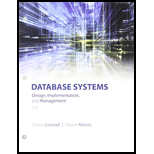
Concept explainers
Normalization:
The process used to minimize data redundancy and dependency in a relational
First normal form (1NF):
- If a table does not contain any replicate fields or groups of fields then that model is called as first normal form.
- In this form, entities do not contain any single instance of the repeating variable.
- It means that the entities contain only one instance of the attributes, multi-valued attributes are neglected.
Second normal form (2NF):
- The value of all non-primary key attributes should be dependent on the primary key attribute.
- If any attribute is depending on the partial primary key then it should determine the other attributes for an instance of the entity.
- The partial dependencies should be removed from the data model.
Third normal form (3NF):
- The value of any non-primary key attributes will not depend on any other non-primary key attributes.
- If any non-primary key attributes depend on any other non-primary key attribute then it should be moved or deleted.
- It is termed as transitive dependency.
Partial dependency:
A partial dependency exists at that time of an attributes depends only a part of primary key. This dependency is related with 1st normal form.
Transitive dependency:
A transitive dependency exists at that time of an attributes depends on another attribute which is not part of primary key.
Functional dependency:
An association between two attributes or two set of attributes in a same relational database table, which is having some constraints is known as functional dependency.
- In a table one attribute is functionally dependent on another attribute to take one value.
Explanation of Solution
b.
Dependencies diagrams for each database table:
Table1:
Create the database table with name of Table1 is given below:
Table1 (C1, C2)
- C2 are partial dependent on C1.
Normal form:
- The relation is in third normal form (3NF), since there is no transitive dependency and no repeated attributes.
The representation of dependency diagram for table1 is shown below:
Explanation of Solution
c.
Dependencies diagrams for each database table:
Table1:
Create the database table with name of Table1 is given below:
Table1 (C1, C2)
- Here, C1 indicate the primary key.
- C2 are partial dependent on C1.
Normal form:
- The relation is in third normal form (3NF), since there is no transitive dependency and no repeated attributes.
The representation of dependency diagram for table1 is shown below:
Table2:
Create the database table with name of Table2 is given below:
Table2 (C1, C3, C4)
- Here, C1 and C3 indicate the primary key and C1 indicates the foreign key that belongs to Table1 and C4 indicates the foreign key that belongs to Table3...
Trending nowThis is a popular solution!

Chapter 6 Solutions
Database Systems: Design, Implementation, Management, Loose-leaf Version
- Write a C program using embedded assembler with a function to convert a digit (0 – 15) to the corresponding ASCII character representing the value in hexadecimal. For numbers 0 – 9, the output will be the characters '0' – '9', for numbers 10 – 15 the characters 'A' – 'F'. The entire core of the program must be written in symbolic instruction language; arrays may not be used. You may only use C to print the result. Tip: This piece of C program will do the same thing: character = number < 10 ? number + '0' : number + 55; As a basis, you can use this program again , which increments a variable. Just replace the INC instruction with ADD and add a test (CMP) with some conditional jump.arrow_forwardAnswer the question fully and accurately by providing the required files(Java Code, Two output files and written answers to questions 1-3 in a word document)meaning question 1 to 3 also provide correct answers for those questions.(note: this quetion is not graded).arrow_forward.NET Interactive Solving Sudoku using Grover's Algorithm We will now solve a simple problem using Grover's algorithm, for which we do not necessarily know the solution beforehand. Our problem is a 2x2 binary sudoku, which in our case has two simple rules: •No column may contain the same value twice •No row may contain the same value twice If we assign each square in our sudoku to a variable like so: 1 V V₁ V3 V2 we want our circuit to output a solution to this sudoku. Note that, while this approach of using Grover's algorithm to solve this problem is not practical (you can probably find the solution in your head!), the purpose of this example is to demonstrate the conversion of classical decision problems into oracles for Grover's algorithm. Turning the Problem into a Circuit We want to create an oracle that will help us solve this problem, and we will start by creating a circuit that identifies a correct solution, we simply need to create a classical function on a quantum circuit that…arrow_forward
- .NET Interactive Solving Sudoku using Grover's Algorithm We will now solve a simple problem using Grover's algorithm, for which we do not necessarily know the solution beforehand. Our problem is a 2x2 binary sudoku, which in our case has two simple rules: •No column may contain the same value twice •No row may contain the same value twice If we assign each square in our sudoku to a variable like so: 1 V V₁ V3 V2 we want our circuit to output a solution to this sudoku. Note that, while this approach of using Grover's algorithm to solve this problem is not practical (you can probably find the solution in your head!), the purpose of this example is to demonstrate the conversion of classical decision problems into oracles for Grover's algorithm. Turning the Problem into a Circuit We want to create an oracle that will help us solve this problem, and we will start by creating a circuit that identifies a correct solution, we simply need to create a classical function on a quantum circuit that…arrow_forwardAnswer two JAVA OOP problems.arrow_forwardAnswer two JAVA OOP problems.arrow_forward
 Database Systems: Design, Implementation, & Manag...Computer ScienceISBN:9781285196145Author:Steven, Steven Morris, Carlos Coronel, Carlos, Coronel, Carlos; Morris, Carlos Coronel and Steven Morris, Carlos Coronel; Steven Morris, Steven Morris; Carlos CoronelPublisher:Cengage Learning
Database Systems: Design, Implementation, & Manag...Computer ScienceISBN:9781285196145Author:Steven, Steven Morris, Carlos Coronel, Carlos, Coronel, Carlos; Morris, Carlos Coronel and Steven Morris, Carlos Coronel; Steven Morris, Steven Morris; Carlos CoronelPublisher:Cengage Learning A Guide to SQLComputer ScienceISBN:9781111527273Author:Philip J. PrattPublisher:Course Technology Ptr
A Guide to SQLComputer ScienceISBN:9781111527273Author:Philip J. PrattPublisher:Course Technology Ptr Database Systems: Design, Implementation, & Manag...Computer ScienceISBN:9781305627482Author:Carlos Coronel, Steven MorrisPublisher:Cengage Learning
Database Systems: Design, Implementation, & Manag...Computer ScienceISBN:9781305627482Author:Carlos Coronel, Steven MorrisPublisher:Cengage Learning Fundamentals of Information SystemsComputer ScienceISBN:9781305082168Author:Ralph Stair, George ReynoldsPublisher:Cengage Learning
Fundamentals of Information SystemsComputer ScienceISBN:9781305082168Author:Ralph Stair, George ReynoldsPublisher:Cengage Learning
 Principles of Information Systems (MindTap Course...Computer ScienceISBN:9781285867168Author:Ralph Stair, George ReynoldsPublisher:Cengage Learning
Principles of Information Systems (MindTap Course...Computer ScienceISBN:9781285867168Author:Ralph Stair, George ReynoldsPublisher:Cengage Learning





